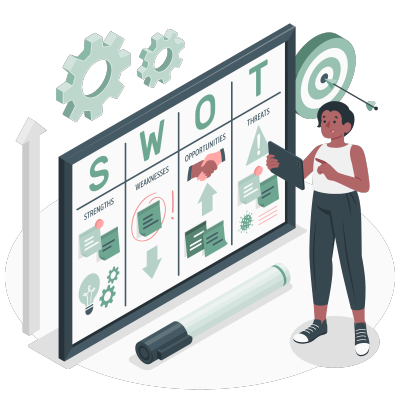As an entrepreneur, you know that in order to be successful, it’s important to understand your competition. In this article, we’ll teach you how to identify your competitors and develop a SWOT analysis for each one. This information will help determine your competitive advantages among similar nonprofits and guide your strategic plan for the nonprofit organization.
How to Identify Competitors
Before examining a SWOT analysis, we need to discuss how to identify your organization’s competitors. This may seem like a daunting task, especially if you’re just starting out, but don’t worry! There are a few key steps you can take to ensure that you’re considering all of the competitive organizations.
- Define your organization’s mission and goals.
This is an important first step because it will help narrow your focus on the goals of a nonprofit organization. Once you have a clear understanding of your mission and goals, you can begin to look for other organizations that share similar values.
- Research similar nonprofits.
Use Google and other search engines to find nonprofits that are working in the same or similar space as your organization. You can also use directories, such as Candid (aka The Foundation Center) to find more information regarding these organizations.
- Identify commonalities among your competitors.
As you’re researching, take note of any commonalities that you see among your competitors. This could include things like size, budget, target population, or geographical location.
What Is A SWOT Analysis?
A SWOT analysis is a tool that organizations use to assess their strengths, weaknesses, opportunities, and threats. This information can be incredibly helpful in determining your competitive advantage.
Strengths
Your organization’s strengths are the qualities that give you an edge over your competition. These could include things like a proven track record, a strong brand, or a passionate team.
Weaknesses
Your organization’s weaknesses are the characteristics that put you at a disadvantage in comparison to your competition. These could include things like a low budget, lack of name recognition, or limited staff.
Opportunities
Your organization’s opportunities are the external factors that could help achieve your goals. These could include things like a growing market, a change in the political landscape, or new technology.
Threats
Your organization’s threats are the external factors that could hinder your ability to achieve your goals. These could include things like a recession, increased competition, or unfavorable regulations.
How to Develop a SWOT Analysis for Each Competitor
Once you’ve identified your competitors, it’s time to develop a SWOT analysis for each one. Here’s how:
Research each competitor thoroughly: Review their website, read their annual reports, and talk to people who are familiar with their work.
Identify their strengths: What are they doing well? What advantages do they have?
Identify their weaknesses: What could they improve? What disadvantages do they have?
Identify their opportunities: What external factors could they take advantage of?
Identify their threats: What external factors could be hindering their success?
Once you’ve completed your SWOT analysis, take a step back and review the information. What does it tell you about your organization’s position in the market? Do you have any competitive advantages that can be used to your organization’s advantage? Are there any areas where you need to improve?
Conclusion
A SWOT analysis is a powerful tool that can help assess your organization’s strengths, weaknesses, opportunities, and threats. By taking the time to develop a SWOT analysis for each of your competitors, you can gain a better understanding of your position in the market and make informed decisions about how to best achieve your goals.

